I'm working with 2D geographical data. I have a long list of contour paths. Now I want to determine for every point in my domain inside how many contours it resides (i.e. I want to compute the spatial frequency distribution of the features represented by the contours).
To illustrate what I want to do, here's a first very naive implementation:
import numpy as np
from shapely.geometry import Polygon, Point
def comp_frequency(paths,lonlat):
"""
- paths: list of contour paths, made up of (lon,lat) tuples
- lonlat: array containing the lon/lat coordinates; shape (nx,ny,2)
"""
frequency = np.zeros(lonlat.shape[:2])
contours = [Polygon(path) for path in paths]
# Very naive and accordingly slow implementation
for (i,j),v in np.ndenumerate(frequency):
pt = Point(lonlat[i,j,:])
for contour in contours:
if contour.contains(pt):
frequency[i,j] += 1
return frequency
lon = np.array([
[-1.10e+1,-7.82+0,-4.52+0,-1.18+0, 2.19e+0,5.59e+0,9.01+0,1.24+1,1.58+1,1.92+1,2.26+1],
[-1.20e+1,-8.65+0,-5.21+0,-1.71+0, 1.81e+0,5.38e+0,8.97+0,1.25+1,1.61+1,1.96+1,2.32+1],
[-1.30e+1,-9.53+0,-5.94+0,-2.29+0, 1.41e+0,5.15e+0,8.91+0,1.26+1,1.64+1,2.01+1,2.38+1],
[-1.41e+1,-1.04+1,-6.74+0,-2.91+0, 9.76e-1,4.90e+0,8.86+0,1.28+1,1.67+1,2.06+1,2.45+1],
[-1.53e+1,-1.15+1,-7.60+0,-3.58+0, 4.98e-1,4.63e+0,8.80+0,1.29+1,1.71+1,2.12+1,2.53+1],
[-1.66e+1,-1.26+1,-8.55+0,-4.33+0,-3.00e-2,4.33e+0,8.73+0,1.31+1,1.75+1,2.18+1,2.61+1],
[-1.81e+1,-1.39+1,-9.60+0,-5.16+0,-6.20e-1,3.99e+0,8.66+0,1.33+1,1.79+1,2.25+1,2.70+1],
[-1.97e+1,-1.53+1,-1.07+1,-6.10+0,-1.28e+0,3.61e+0,8.57+0,1.35+1,1.84+1,2.33+1,2.81+1],
[-2.14e+1,-1.69+1,-1.21+1,-7.16+0,-2.05e+0,3.17e+0,8.47+0,1.37+1,1.90+1,2.42+1,2.93+1],
[-2.35e+1,-1.87+1,-1.36+1,-8.40+0,-2.94e+0,2.66e+0,8.36+0,1.40+1,1.97+1,2.52+1,3.06+1],
[-2.58e+1,-2.08+1,-1.54+1,-9.86+0,-3.99e+0,2.05e+0,8.22+0,1.44+1,2.05+1,2.65+1,3.22+1]])
lat = np.array([
[ 29.6, 30.3, 30.9, 31.4, 31.7, 32.0, 32.1, 32.1, 31.9, 31.6, 31.2],
[ 32.4, 33.2, 33.8, 34.4, 34.7, 35.0, 35.1, 35.1, 34.9, 34.6, 34.2],
[ 35.3, 36.1, 36.8, 37.3, 37.7, 38.0, 38.1, 38.1, 37.9, 37.6, 37.1],
[ 38.2, 39.0, 39.7, 40.3, 40.7, 41.0, 41.1, 41.1, 40.9, 40.5, 40.1],
[ 41.0, 41.9, 42.6, 43.2, 43.7, 44.0, 44.1, 44.0, 43.9, 43.5, 43.0],
[ 43.9, 44.8, 45.6, 46.2, 46.7, 47.0, 47.1, 47.0, 46.8, 46.5, 45.9],
[ 46.7, 47.7, 48.5, 49.1, 49.6, 49.9, 50.1, 50.0, 49.8, 49.4, 48.9],
[ 49.5, 50.5, 51.4, 52.1, 52.6, 52.9, 53.1, 53.0, 52.8, 52.4, 51.8],
[ 52.3, 53.4, 54.3, 55.0, 55.6, 55.9, 56.1, 56.0, 55.8, 55.3, 54.7],
[ 55.0, 56.2, 57.1, 57.9, 58.5, 58.9, 59.1, 59.0, 58.8, 58.3, 57.6],
[ 57.7, 59.0, 60.0, 60.8, 61.5, 61.9, 62.1, 62.0, 61.7, 61.2, 60.5]])
lonlat = np.dstack((lon,lat))
paths = [
[(-1.71,34.4),(1.81,34.7),(5.15,38.0),(4.9,41.0),(4.63,44.0),(-0.03,46.7),(-4.33,46.2),(-9.6,48.5),(-8.55,45.6),(-3.58,43.2),(-2.91,40.3),(-2.29,37.3),(-1.71,34.4)],
[(0.976,40.7),(-4.33,46.2),(-0.62,49.6),(3.99,49.9),(4.33,47.0),(4.63,44.0),(0.976,40.7)],
[(2.9,55.8),(2.37,56.0),(8.47,56.1),(3.17,55.9),(-2.05,55.6),(-1.28,52.6),(-0.62,49.6),(4.33,47.0),(8.8,44.1),(2.29,44.0),(2.71,43.9),(3.18,46.5),(3.25,49.4),(3.33,52.4),(2.9,55.8)],
[(2.25,35.1),(2.26,38.1),(8.86,41.1),(5.15,38.0),(5.38,35.0),(9.01,32.1),(2.25,35.1)]]
frequency = comp_frequency(paths,lonlat)
Of course this is about as inefficiently written as possible, with all the explicit loops, and accordingly takes forever.
How can I do this efficiently?
Edit: Added some sample data on request. Note that my real domain is 150**2 larger (in terms of resolution), as I've created the sample coordinates by slicing the original arrays: lon[::150].
